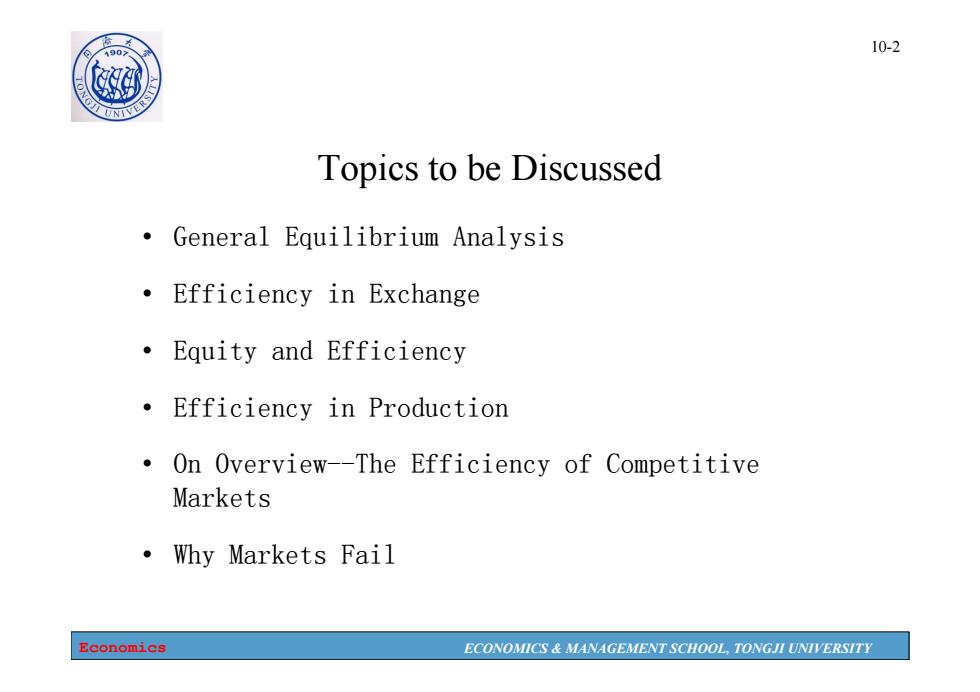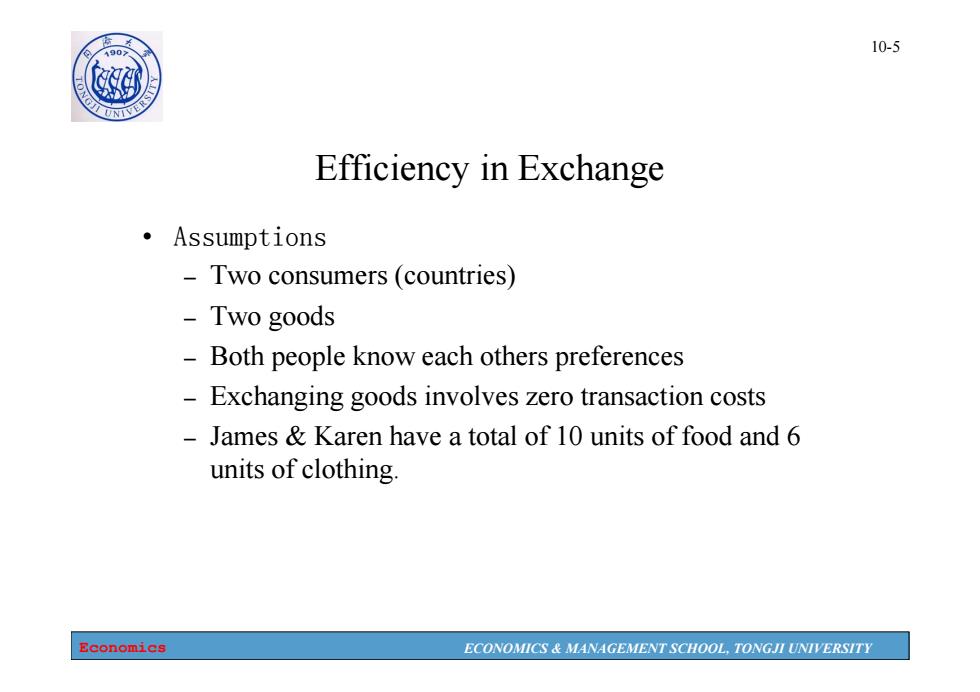
1907 Ch07 General Equilibrium and Economic Efficiency Economics ECONOMICS MANAGEMENT SCHOOL,TONGJI UNIVERSITY
Economics ECONOMICS & MANAGEMENT SCHOOL, TONGJI UNIVERSITY Ch07 General Equilibrium and Economic Efficiency

40 10-2 © Topics to be Discussed General Equilibrium Analysis Efficiency in Exchange Equity and Efficiency Efficiency in Production On Overview--The Efficiency of Competitive Markets ·Why Markets Fail Economics ECONOMICS MANAGEMENT SCHOOL,TONGJI UNIVERSITY
Economics ECONOMICS & MANAGEMENT SCHOOL, TONGJI UNIVERSITY 10-2 Topics to be Discussed • General Equilibrium Analysis • Efficiency in Exchange • Equity and Efficiency • Efficiency in Production • On Overview--The Efficiency of Competitive Markets • Why Markets Fail

190 10-3 7.1 General Equilibrium Analysis Partial equilibrium analysis presumes that activity in one market is independent of other markets. General equilibrium analysis determines the prices and quantity in all markets simultaneously and takes the feedback effect into account. A feedback effect is a price or quantity adjustment in one market caused by price and quantity adjustments in related markets. Economics ECONOMICS MANAGEMENT SCHOOL,TONGJI UNIVERSITY
Economics ECONOMICS & MANAGEMENT SCHOOL, TONGJI UNIVERSITY 10-3 7.1 General Equilibrium Analysis • Partial equilibrium analysis presumes that activity in one market is independent of other markets. • General equilibrium analysis determines the prices and quantity in all markets simultaneously and takes the feedback effect into account. • A feedback effect is a price or quantity adjustment in one market caused by price and quantity adjustments in related markets

10-4 N 7.2 Efficiency in Exchange Exchange increases efficiency until no one can be made better off without making someone else worse off (Pareto efficiency). The Advantages of Trade Trade between two parties is mutually beneficial. Economics ECONOMICS MANAGEMENT SCHOOL,TONGJI UNIVERSITY
Economics ECONOMICS & MANAGEMENT SCHOOL, TONGJI UNIVERSITY 10-4 7.2 Efficiency in Exchange • Exchange increases efficiency until no one can be made better off without making someone else worse off (Pareto efficiency). • The Advantages of Trade – Trade between two parties is mutually beneficial

1907 10-5 Efficiency in Exchange ·Assumptions Two consumers(countries) Two goods Both people know each others preferences Exchanging goods involves zero transaction costs James Karen have a total of 10 units of food and 6 units of clothing Economics ECONOMICS MANAGEMENT SCHOOL,TONGJI UNIVERSITY
Economics ECONOMICS & MANAGEMENT SCHOOL, TONGJI UNIVERSITY 10-5 Efficiency in Exchange • Assumptions – Two consumers (countries) – Two goods – Both people know each others preferences – Exchanging goods involves zero transaction costs – James & Karen have a total of 10 units of food and 6 units of clothing

10-6 The Advantage of Trade Individual Initial Allocation Trade Final Allocation James 7E,1C -1F,+1C 6P,2C Karen 3F,5C +1F,-1C 4℉,4C Karen's MRS of food for clothing is 3. James's MRS of food for clothing is 1/2. Karen and James are willing to trade:Karen trades 1C for 1F.When the MRS is not equal, there is gain from trade.The economically efficient allocation occurs when the MRS is equal. Economics ECONOMICS MANAGEMENT SCHOOL,TONGJI UNIVERSITY
Economics ECONOMICS & MANAGEMENT SCHOOL, TONGJI UNIVERSITY 10-6 The Advantage of Trade James 7F, 1C -1F, +1C 6F, 2C Karen 3F, 5C +1F, -1C 4F, 4C Individual Initial Allocation Trade Final Allocation Karen’s MRS of food for clothing is 3. James’s MRS of food for clothing is 1/2. Karen and James are willing to trade: Karen trades 1C for 1F. When the MRS is not equal, there is gain from trade. The economically efficient allocation occurs when the MRS is equal

1907 10-7 Efficiency in Exchange The Edgeworth Box Diagram Which trades can occur and which allocation will be efficient can be illustrated using a diagram called an Edgeworth Box. Economics ECONOMICS MANAGEMENT SCHOOL,TONGJI UNIVERSITY
Economics ECONOMICS & MANAGEMENT SCHOOL, TONGJI UNIVERSITY 10-7 Efficiency in Exchange • The Edgeworth Box Diagram – Which trades can occur and which allocation will be efficient can be illustrated using a diagram called an Edgeworth Box

Exchange in an Edgeworth Box Karen's Food 10F 4F 3F 6C The initial allocation The allocation before trade is A:James after trade is B:James has 7F and 1C Karen has 6F and 2C Karen has 3F and 5C. has 4F and 4C. James's Karen's Clothing Clothing 2C 4C +1C 1C 5C -1F1A 6C 0 6F 7F 10F James's Food
Exchange in an Edgeworth Box 10F 0 K 0 J 6C 10F 6C James’s Clothing Karen’s Clothing Karen’s Food James’s Food 2C 1C 5C 4C 4F 3F 6F 7F +1C -1F The allocation after trade is B: James has 6F and 2C & Karen has 4F and 4C. A B The initial allocation before trade is A: James has 7F and 1C & Karen has 3F and 5C

10-9 1907 Efficiency in Exchange 。 Efficient Allocations If James's and Karen's MRS are the same at B the allocation is efficient. This depends on the shape of their indifference curves Economics ECONOMICS MANAGEMENT SCHOOL,TONGJI UNIVERSITY
Economics ECONOMICS & MANAGEMENT SCHOOL, TONGJI UNIVERSITY 10-9 Efficiency in Exchange • Efficient Allocations – If James’s and Karen’s MRS are the same at B the allocation is efficient. • This depends on the shape of their indifference curves

10-10 0 10F Efficiency in Exchangod OK 6C A:U1=Ux, but the MRS is not equal. All combinations in the shaded area are James's preferred to A. Karen's Clothing Clothing Gains from trade U,1 6C 0 James's Food 10F Economics ECONOMICS MANAGEMENT SCHOOL,TONGJI UNIVERSITY
Economics ECONOMICS & MANAGEMENT SCHOOL, TONGJI UNIVERSITY 10-10 A A: UJ1 = UK1, but the MRS is not equal. All combinations in the shaded area are preferred to A. Gains from trade Karen’s Clothing Karen’s Food UK U 1 K U 2 K3 James’s Clothing James’s Food UJ1 UJ2 UJ3 B C D Efficiency in Exchange 10F 0K 0J 6C 10F 6C